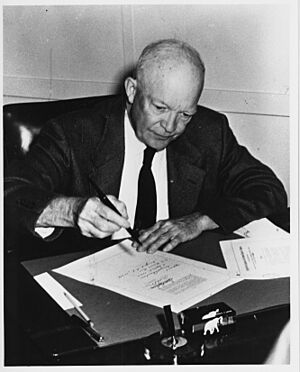Civil Rights Act of 1957 facts for kids
 |
|
| Long title | An Act to provide means of further securing and protecting the civil rights of persons within the jurisdiction of the United States. |
|---|---|
| Enacted by | the 85th United States Congress |
| Effective | September 9, 1957 |
| Citations | |
| Public law | 85-315 |
| Statutes at Large | 71 Stat. 634 |
| Legislative history | |
|
|
| Major amendments | |
| Civil Rights Act of 1960 Civil Rights Act of 1964 |
|
The Civil Rights Act of 1957 was a very important law in the United States. It was the first federal law about civil rights passed in 82 years! The United States Congress passed this bill, and President Dwight D. Eisenhower signed it into law on September 9, 1957.
This law came about after the Supreme Court decided in 1954 that schools could not be separated by race. This ruling, called Brown v. Board of Education, made many Southern leaders upset. They started a movement called "massive resistance" to stop schools from integrating.
President Eisenhower wanted to protect the voting rights of Black Americans. Many Black Americans in the Southern United States were not allowed to vote because of unfair state and local laws. Even though the bill passed, some parts were changed or made weaker. This happened because of special amendments, which are changes to a bill.
One famous event during the debate was when Senator Strom Thurmond talked for over 24 hours straight to try and stop the bill. This is called a filibuster. Even though the law was weakened, it still created two important groups: the United States Commission on Civil Rights and the United States Department of Justice Civil Rights Division. These groups would work to protect civil rights.
Later, Congress passed stronger civil rights laws. These included the Civil Rights Act of 1960, the Civil Rights Act of 1964, and the Voting Rights Act of 1965.
Contents
Why the Act Was Needed
After the Supreme Court said schools must integrate, many white people in the South resisted. This resistance sometimes led to difficult situations. For example, in Little Rock, Arkansas, President Eisenhower had to send U.S. soldiers to protect nine Black teenagers. These students were trying to attend a public school that had been all white. This was the first time federal troops were used in the South for civil rights issues since the Reconstruction Era.
By 1957, only about 20% of Black people could vote. Even in areas where they were the majority, many Black Americans were prevented from voting. This was due to unfair rules like literacy tests (where you had to read and understand difficult texts) and poll taxes (where you had to pay to vote). These rules had been put in place by Southern states. The federal government stepped in to make sure all citizens could vote for national leaders.
How the Law Was Passed
The Democratic leader in the Senate, Lyndon B. Johnson from Texas, played a big role. He knew the bill could cause problems within his party. Southern Democrats were against civil rights, while Northern Democrats strongly supported them. Johnson sent the bill to a committee led by Senator James Eastland, who changed the bill a lot.
Republicans also supported the bill. They saw it as a way to help Black voters, who might then support the Republican party. They also hoped it would divide the Democratic party. Both sides had their reasons for wanting the bill to pass, even if they wanted different versions of it.
Changes to the Bill
A group of Senators realized that Southern Senators would not let the bill pass with a part called Title III. This part would have given the U.S. Attorney General (the country's top lawyer) power to stop civil rights problems. Senator Johnson convinced Senator Clinton Anderson to suggest a change to remove these strong enforcement powers. Another Senator, George Aiken, joined him.
A key reason for weakening Title III was a speech by Senator Richard Russell. He explained that Title III was not a new law but an old one from the Reconstruction era. He pointed out that it could allow the President to use the military to enforce court decisions, like the Brown v Board ruling. This idea of military involvement worried many, even some who supported civil rights.
President Eisenhower himself said that Title III might be "too far too fast." He focused more on the voting rights parts of the bill. This made many Republicans less likely to support Title III, as they worried about the federal government gaining too much power. The change to remove Title III's strong enforcement passed by a vote of 52 to 38.
Jury Trial Amendment
Senator Johnson also worked to weaken the voting rights parts of the bill. He wanted to add a rule that people accused of stopping others from voting would get a jury trial. In the South, juries were often all white. This meant that people who stopped Black Americans from voting would likely not be found guilty. This would make it very hard to protect voting rights.
This change was suggested by Senator Joseph C. O'Mahoney from Wyoming. Some Western Democrats supported it because they didn't like how much power judges had in labor disputes. They felt that jury trials would give more power to regular people. Some labor unions also supported this idea.
On August 2, 1957, the Senate passed the jury trial amendment. Many Republicans were very upset. Vice President Richard Nixon said it was "one of the saddest days in the history of the Senate."
The Filibuster
Senator Strom Thurmond from South Carolina was strongly against the bill. He tried to stop it by talking for 24 hours and 18 minutes straight. This is the longest one-person filibuster in Senate history. He read election laws, the Declaration of Independence, and other documents.
Other Southern Senators were part of a deal not to filibuster the bill. They were annoyed with Thurmond because his actions made them look bad to their voters.
Final Vote
The bill finally passed in the House of Representatives by a vote of 285 to 126. Most members from both parties supported it. It then passed in the Senate by a vote of 72 to 18. President Eisenhower signed the bill into law on September 9, 1957.
The Act created the Commission on Civil Rights. It also created a new job: Assistant Attorney General for Civil Rights. This led to the creation of the Civil Rights Division within the Justice Department. This new division would focus only on civil rights cases.
What the Act Did
Part I: Civil Rights Commission
This part created a group of six members called the Civil Rights Commission. Their job was to gather information about how people's voting rights were being taken away because of their race, religion, or background. They also looked at laws and policies related to voting rights. The commission would listen to people's stories about problems with voting and then report their findings to Congress and the President.
Part II: New Assistant Attorney General
This part added a new Assistant Attorney General. This person would be appointed by the President and approved by the Senate. This new role helped lead the new Civil Rights Division.
Part III: Strengthening Civil Rights Laws
This section made small changes to existing laws to include civil rights. It aimed to strengthen the government's ability to protect civil rights.
Part IV: Protecting the Right to Vote
This was a very important part. It made it illegal to scare, pressure, or stop people from voting for President or members of Congress. The United States attorney general could take action against those who broke this law. This could include getting a court order (an injunction) or charging them with contempt of court.
This part also changed how federal juries were chosen. Before, federal juries often followed state rules, which sometimes kept Black people and women from serving. The Act said that any citizen 21 or older, who could read and write English, and had lived in the area for a year, could be a juror. This helped make juries more fair and diverse.
Part V: Jury Trials for Contempt Cases
This part dealt with how people accused of ignoring court orders in civil rights cases would be punished. It also set rules for who could be on a federal jury. It said that people convicted of serious crimes, those who couldn't understand English, or those with severe mental or physical problems could not serve on a jury. This section also officially named the law the "Civil Rights Act of 1957."
Later Civil Rights Laws
The Civil Rights Act of 1957 was a start, but it had its limits. The Civil Rights Act of 1960 tried to fix some of these problems. It gave federal judges more power to protect voting rights. It also made local governments keep better records of voting. This helped the government see if people were being discriminated against.
The Civil Rights Movement kept growing. People held peaceful protests to demand equal rights. President John F. Kennedy asked for a new civil rights law in 1963. He wanted to make sure all Americans could use public places like hotels and restaurants. He also wanted stronger protection for voting rights.
After President Kennedy was assassinated, President Lyndon Johnson helped pass the Civil Rights Act of 1964. This law made it illegal to discriminate based on race and made segregation illegal. He also helped pass the Voting Rights Act of 1965. This law got rid of poll taxes and other unfair ways of stopping people from voting. It also allowed the federal government to oversee elections in places where discrimination was common.
What Changed Because of the Act
Even though the 1957 Act was a big step, its immediate impact was limited. The changes made to the bill made it hard to enforce. By 1960, only 3% more Black Americans were voting. However, it showed that the federal government was starting to get more involved in civil rights.
Martin Luther King Jr., who was a young leader in the Civil Rights Movement, spoke out against unfair treatment. He tried to meet with President Eisenhower to ask for his strong support. While Eisenhower didn't make another speech, he did send Vice President Richard Nixon to meet with King. Nixon was impressed with King and told Eisenhower that he should meet him later.


